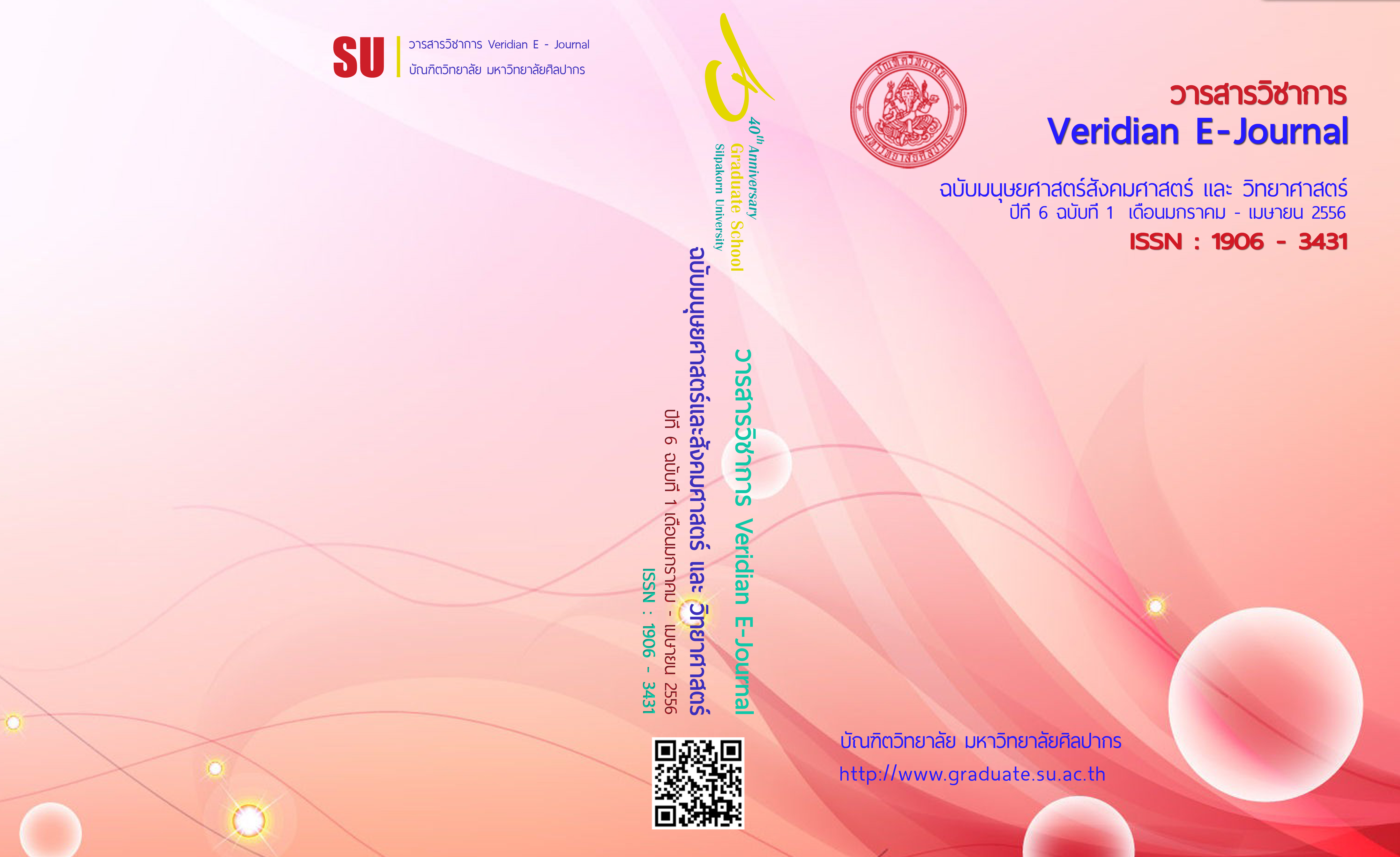การเปรียบเทียบประสิทธิภาพของสถิติสำหรับทดสอบความเท่ากันของความแปรปรวน
Main Article Content
Abstract
บทคัดย่อ
การศึกษาวิจัยครั้งนี้ ผู้วิจัยมีความสนใจศึกษา และเปรียบเทียบประสิทธิภาพของตัวสถิติสำหรับทดสอบความเท่ากันของความแปรปรวนของประชากร 3 และ 4 กลุ่ม จำนวน 3 วิธี คือ สถิติบราวน์ – ฟอร์สิตี้ (BF) สถิติ ANOMV (AV) และสถิติจีนี่ (GT) โดยพิจารณาประสิทธิภาพของตัวสถิติทั้ง 3 วิธี จากการเปรียบเทียบกำลังการทดสอบของตัวสถิติที่สามารถควบคุมความน่าจะเป็นของความคลาดเคลื่อนประเภทที่ 1 ได้ เมื่อกำหนดการแจกแจงของประชากรเป็นแบบปกติมีค่าเฉลี่ยเท่ากับ 0 ขนาดตัวอย่างเล็กกลาง และใหญ่ ยกเว้นสถิติ AV ที่จะทำการศึกษาเฉพาะตัวอย่างขนาดกลาง โดยกำหนดให้สำหรับแต่ละกลุ่มประชากรที่เปรียบเทียบมีขนาดตัวอย่างเท่ากัน เมื่อกำหนดระดับความแตกต่างของแปรปรวน 3 ระดับคือ น้อย ปานกลาง และมาก ที่ระดับนัยสำคัญ 0.01 และ 0.05 จำลองข้อมูลด้วยเทคนิคมอนติคาร์โล ทำซ้ำ 1000 ครั้งในแต่ละสถานการณ์ ผลการศึกษาพบว่า เมื่อตัวอย่างขนาดเล็ก สถิติ GT สามารถควบคุมความน่าจะเป็นของความคลาดเคลื่อนประเภทที่ 1 ได้ทั้งกรณีประชากร 3 และ 4 กลุ่ม ทุกระดับนัยสำคัญ เมื่อตัวอย่างขนาดกลาง สถิติ BF และสถิติ AV สามารถควบคุมความน่าจะเป็นของความคลาดเคลื่อนประเภทที่ 1 ได้ทั้งกรณีประชากร 3 และ 4 กลุ่ม ทุกระดับนัยสำคัญ ส่วนสถิติ GT สามารถควบคุมความน่าจะเป็นของความคลาดเคลื่อนประเภทที่ 1 ได้กรณีประชากร 4 กลุ่ม ที่ระดับนัยสำคัญ 0.01 เมื่อตัวอย่างขนาดใหญ่ สถิติ BF สามารถควบคุมความน่าจะเป็นของความคลาดเคลื่อนประเภทที่ 1 ได้ทั้งกรณีประชากร 3 และ 4 กลุ่ม ที่ทุกระดับนัยสำคัญ ส่วนสถิติ GT สามารถควบคุมความน่าจะเป็นของความคลาดเคลื่อนประเภทที่ 1 ได้กรณีประชากร 3 กลุ่ม ที่ระดับนัยสำคัญ 0.01 ส่วนเมื่อกรณีประชากร 4 กลุ่ม สถิติ GT สามารถควบคุมความน่าจะเป็นของความคลาดเคลื่อนประเภทที่ 1 ได้ ทุกระดับนัยสำคัญ และเมื่อเปรียบเทียบกำลังการทดสอบของตัวสถิติที่สามารถควบคุมความน่าจะเป็นของความคลาดเคลื่อนประเภทที่ 1 ได้ พบว่า เมื่อตัวอย่างขนาดเล็ก สถิติ GT ให้ค่ากำลังการทดสอบต่ำ เมื่อตัวอย่างขนาดกลาง สถิติ AV ให้ค่ากำลังการทดสอบสูงกว่าสถิติ BF ที่ทุกระดับของ ยกเว้นกรณีประชากร 4 กลุ่ม และระดับนัยสำคัญ 0.01 สถิติ GT จะให้ค่ากำลังการทดสอบสูงสุดในทุกระดับของ เมื่อตัวอย่างขนาดใหญ่ สถิติ BF และสถิติ GT ให้ค่ากำลังการทดสอบสูงใกล้เคียงกัน และเมื่อค่าระดับนัยสำคัญ จำนวนกลุ่มประชากร และระดับความแตกต่างของความแปรปรวนเพิ่มขึ้น สถิติทั้ง 3 วิธี มีแนวโน้มจะให้ค่ากำลังการทดสอบเพิ่มขึ้น
ABSTRACT
The objectives of this research are to study and compare power of the test for the three test statistics of homogeneity of variance of 3 and 4 populations which are Brown Forsythe’s test (BF), Analysis of means test for variances (AV) and Gini’s test (GT). The probability of type I error and power of the test statistics were considered. The normality distributed population with mean equal to zero, small, medium and large sample sizes are studied, except for AV, which are studied, only for medium sample size. Each compared populations had equal sample sizes. The three difference levels of variance : low, medium and high for significant levels 0.01 and 0.05 are studied. The data were generated by the Monte Carlo technique repeated 1,000 times for each situation. The results showed that, for small sample size, GT can control the probability of type I error in every cases. For medium sample size, both BF and AV can control the probability of type I error in every cases, but GT can control the probability of type I error for 4 populations groups at 0.01 significant level. For large sample size, BF can control the probability of type I error in every cases, GT can control the probability of type I error for 3 populations groups at 0.01 significant level, however for 4 populations groups GT can control the probability of type I error every significant levels. Consequently, only the test statistics that can control the probability of type I error were compared power of the test. In case of small sample size, GT had low power of the test. When medium sample size, AV had power of the test more than BF for every difference levels of variance, except for 4 populations groups at 0.01 significant level, GT had maximum power of the test for every difference levels of variance. When large sample size, both BF and GT had high power of the test very close. Moreover, when the difference of population variances increases, the power of the three test statistics increase. Also, when the significant levels, the number of population groups and the difference levels of variance increases, power of the test for the three tests tends to increase.
